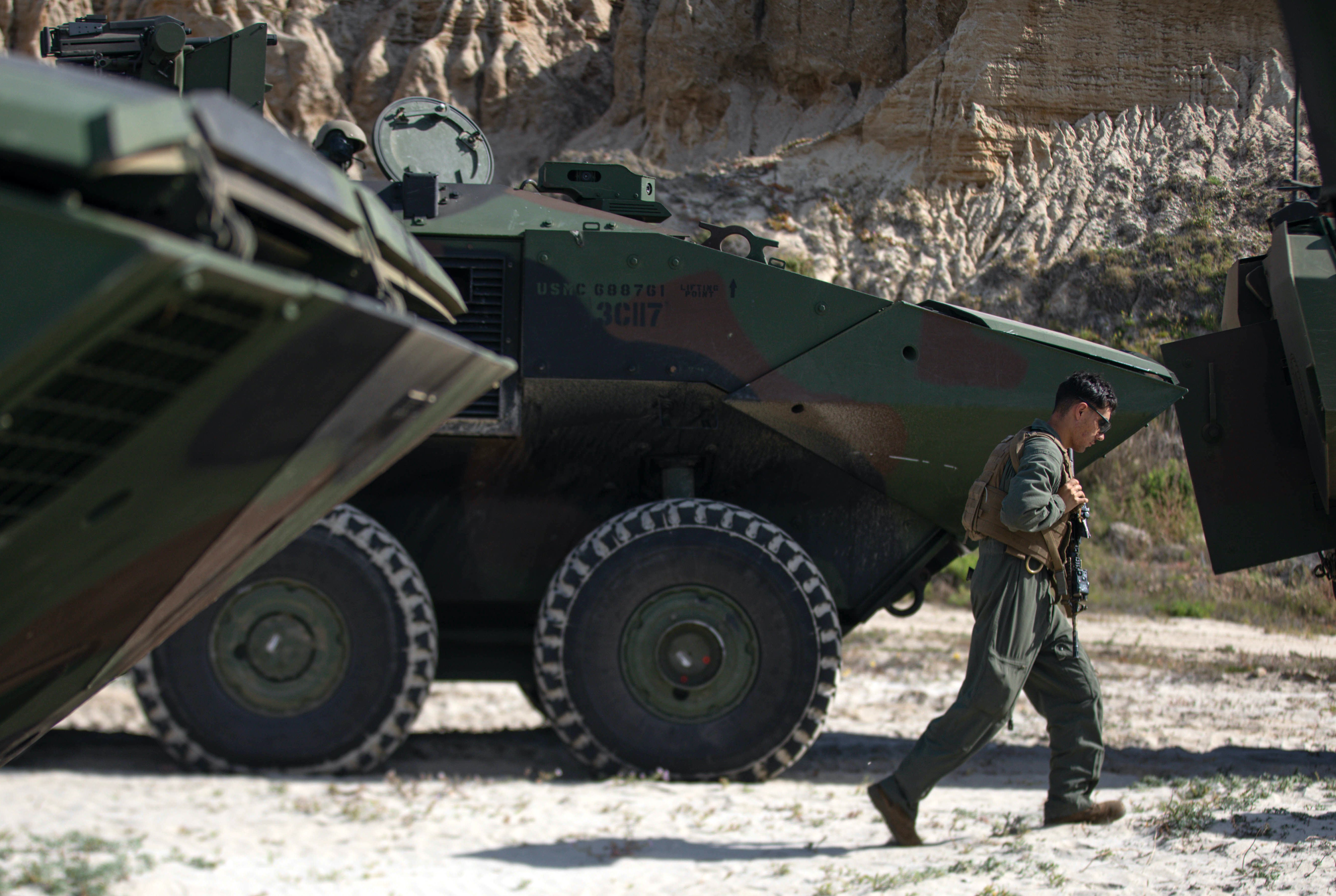
CAMP PENDLETON, Calif. – The nearly dozen amphibious combat vehicles swam toward the shore, their shuttered hatches providing long-slung silhouettes in the Pacific as USS Anchorage (LPD-23) lingered a mile offshore. Two Navy safety boats from the amphibious transport dock ship trailed in slight swells as the ACVs rolled onto the California sands.
Last weekend’s beach landing was significant for two reasons: It marked another milestone in the Marine Corps’ ACV program, as the first operational platoon prepares for the inaugural deployment later this year. And the integrated Navy-Marine Corps training – with day and night, full-mission profile missions launching and recovering vehicles from Anchorage and the beach – was another step in resuming shipboard operations after a pause due to ACV tow-hitch problems and the 2020 fatal amphibious assault vehicle sinking during shore-to-ship training off the California coast.
The deployment will be historic. The Marine Corps is counting on the ACV to be more capable, more lethal and more survivable than the 1970s-era AAV and the new vehicles are key to the service’s ability to conduct amphibious operations, particularly in island-hopping campaigns and other operations in littoral environments. Apart from having wheels instead of tracks, differences between the vehicles – largely from more advanced communications, command-and-control systems and a remote weapon system – will drive changes in how Marines utilize the vehicles and how commanders employ them at sea and ashore.
The four-day, platoon-level training event built on section-level training the Marines did for the first tie at sea with Anchorage in February.
“We’re working through a lot of things, like who determines who is going to splash us, do I submit that I want to splash here, or do they tell me I’m going to splash you here,” 1st Lt. Turner Brown, 1st Platoon commander with Charlie Company, 3rd Assault Amphibian Battalion, said while taking a break in his command vehicle on the beach. “We’re definitely still at the ‘walk’ phase. We’re not yet running.”
Brown said time spent together at sea, as well as several days doing “dry runs” of ACVs aboard Anchorage staying pierside at Naval Base San Diego, Calif., helped build relationships with ship’s company, including key personnel such as the captain, first lieutenant and deck department. His section leaders are sergeants and staff sergeants with considerable experience operating ACVs and AAVs, the tracked amphibious assault vehicles that will be retired when the Marine Corps fully transitions to the new, eight-wheeled combat vehicle later this decade.
The platoon has logged about 53 days of waterborne operations so far, “so we are highly proficient in the water,” he said.
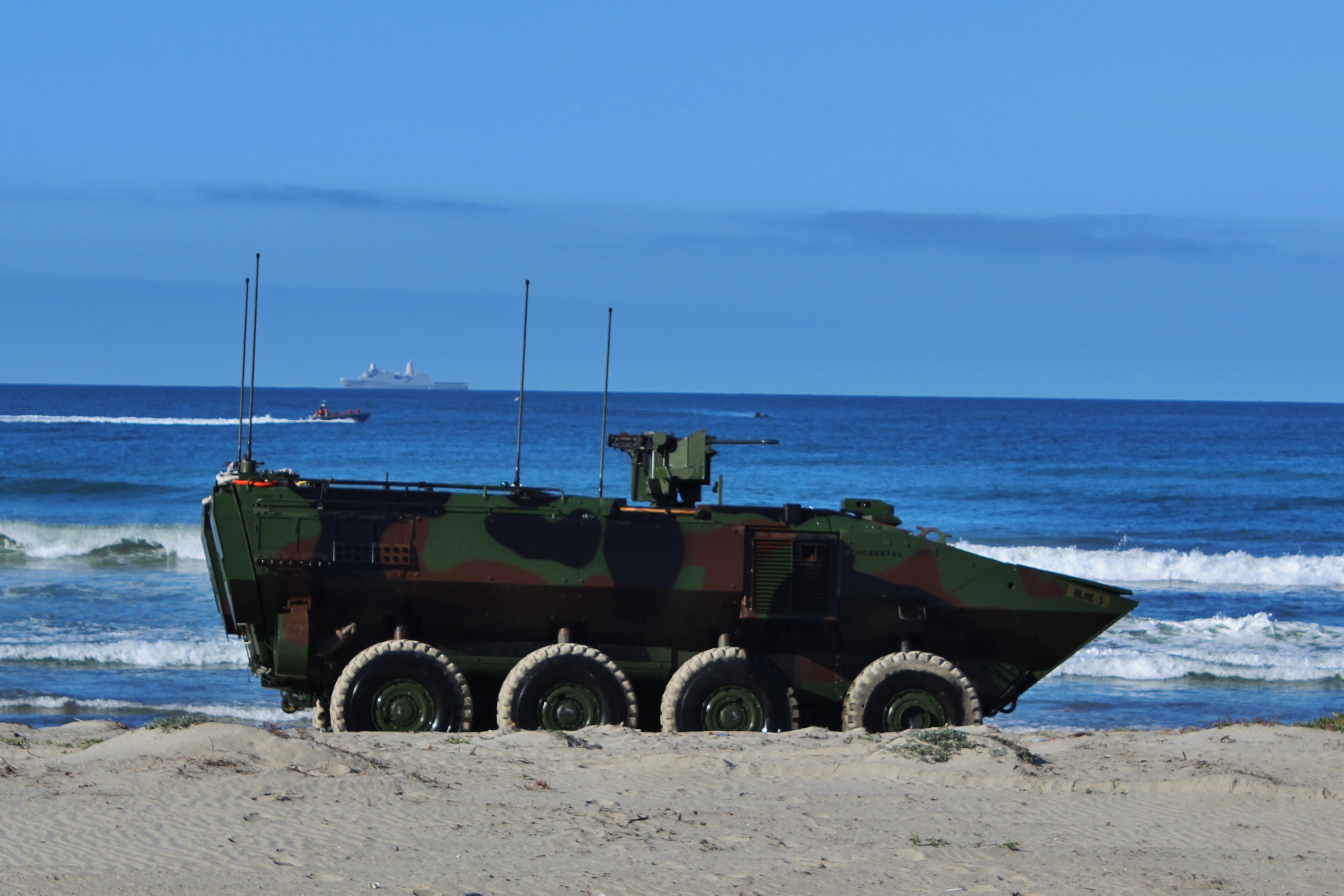
The ACV platoon, which falls under Camp Pendleton-based 1st Marine Division, became the first certified to the Marine Corps’ training and readiness standards, officials said. Next month, they will return to sea with Anchorage and begin pre-deployment training integrated in Battalion Landing Team 2/4, formed around 2nd Battalion, 4th Marines, providing the ground combat element of the 13th Marine Expeditionary Unit.
“After every evolution, I’ve been capturing lessons-learned,” said Capt. Pete Riebe, the commander of Anchorage, which is part of San Diego-based Expeditionary Strike Group 3. “With the new vehicle comes new capabilities, and potentially some new limitations as well.”
“We see ourselves in the leading edge of the new vehicle implementation, and we want to make sure we don’t pass up any opportunity to advance the tactics, techniques and procedures of the blue-green team to take it to the fight,” Riebe told USNI News by phone last week. “That’s what it’s all about – delivering Marines to the fight and making sure we can do it efficiently and effectively. So we take that role very seriously.”
The training was the first time the full ACV platoon did both daytime and nighttime splashing off Anchorage, operating nearby as the ship maneuvered at sea, going ashore and recovering onto the ship’s well-deck. In February, ACV sections trained with the ship at anchor for several days of daytime launch-and-recovery operations. At every evolution “we’re thinking of tactical application. What are we doing? How are we doing this in a contested environment?” Riebe said. “If the ship can’t get that close (to shore), how far can they swim?”
“(We’re) thinking about the next level, to ensure … we can deploy battle-ready and ready for any action the team may see,” he said. While at sea, Anchorage also recovered and launched Navy landing craft and Marine combat rubber-raiding craft with a different infantry battalion.
“There’s certainly increased interest in our return-to-water operations,” added Riebe. He’s briefed Maj. Gen. Roger Turner, the division commander, and Rear Adm. Michael Baze, ESG-3 commander, “to ensure that our training objectives are clear and the plan is known by all and that everyone agrees upon the operations that we’re going to execute out at sea.”
The 1st Marine Division expects to have 100 ACVs by this summer and will transition two of its three AAV companies to the new vehicle by year’s end. “We’ve been on this crawl-walk-run approach as we try to integrate this new platform,” Turner said. The lifting of waterborne restrictions timed with the availability of Anchorage to give the first platoon invaluable time to get ready before it chops to the MEU and begins that busy workup period. “We’re just trying to maximize any time we can get a ship off the coast here, we’re going to get as many reps and sets as we can,” he said.
Col. Philip Laing, the assistant division commander, noted that the ACV Platoon’s waterborne training with Anchorage could have occurred later in the workup cycle but might have detracted from MEU-level training. “They’re setting the exercise framework and training progression on what right looks like, and they’re breaking ground,” Laing said. “We’re learning everyday. How do we integrate with the Navy? What’s the training requirement? What’s the progression? What resources are necessary. How do you organize, train and equip an ACV platoon to support a battalion landing team?”
New Safety Measures
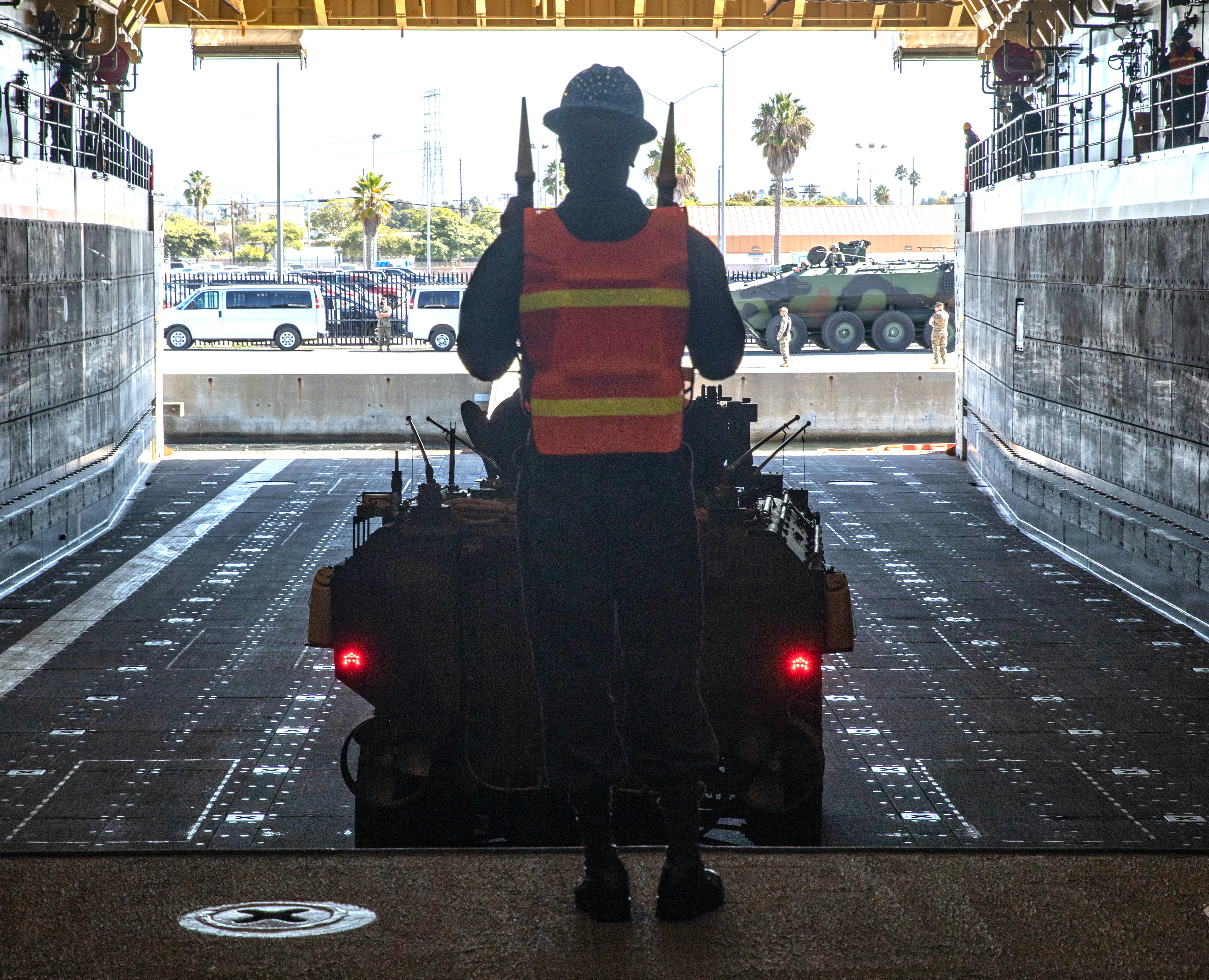
Three separate investigations into the 2020 sinking that led to the loss of eight Marines and one sailor revealed significant problems and failures at nearly every level of command during that ill-fated shore-to-ship training event. They also highlighted problems from Marines’ and sailors’ inexperience with shipboard amphibious operations, most recently due to the suspension of waterborne shipboard operations and to limited integrated exercises or operations involving Marines and amphibious ships, aside from Marine expeditionary units that deployed with Navy amphibious ready groups.
Since 2020, the Marine Corps and the Navy have revamped training requirements, safety protocols, emergency egress procedures, and both have codified many actions that, in the past, were considered “best practices” but inconsistently applied. Many of these were put into place during the February and March drills with Anchorage, which last year wrapped up a shipyard maintenance period and was able to do the ACV training before the ship begins its pre-deployment training program ahead of its ARG/MEU deployment.
Riebe said he and his leaders “have studied the tragedy very closely and understand how and where things broke down.”
Several key changes are now in place.
As ship’s captain, and per clarified Navy and Marine Corps policies, Riebe makes the call to launch the ACVs and green-lighted their return from shore back to Anchorage. “It’s crystal clear,” he said. “They are required to get permission from me to launch from the beach before commencing a swim out to the ship. There’s been no question on that requirement, and the team has had no problem following that requirement.”
A sailor served as an additional lookout when ACVs were in the water. “We have a lookout that’s posted on the ship, and his or her sole responsibility is to maintain a watchful eye on the ACVs,” he said. “We’ve conducted training with the bridge team and our combat operations center team on monitoring their location, and we tracked them on our ship’s radar system the whole while they’re in the water.”
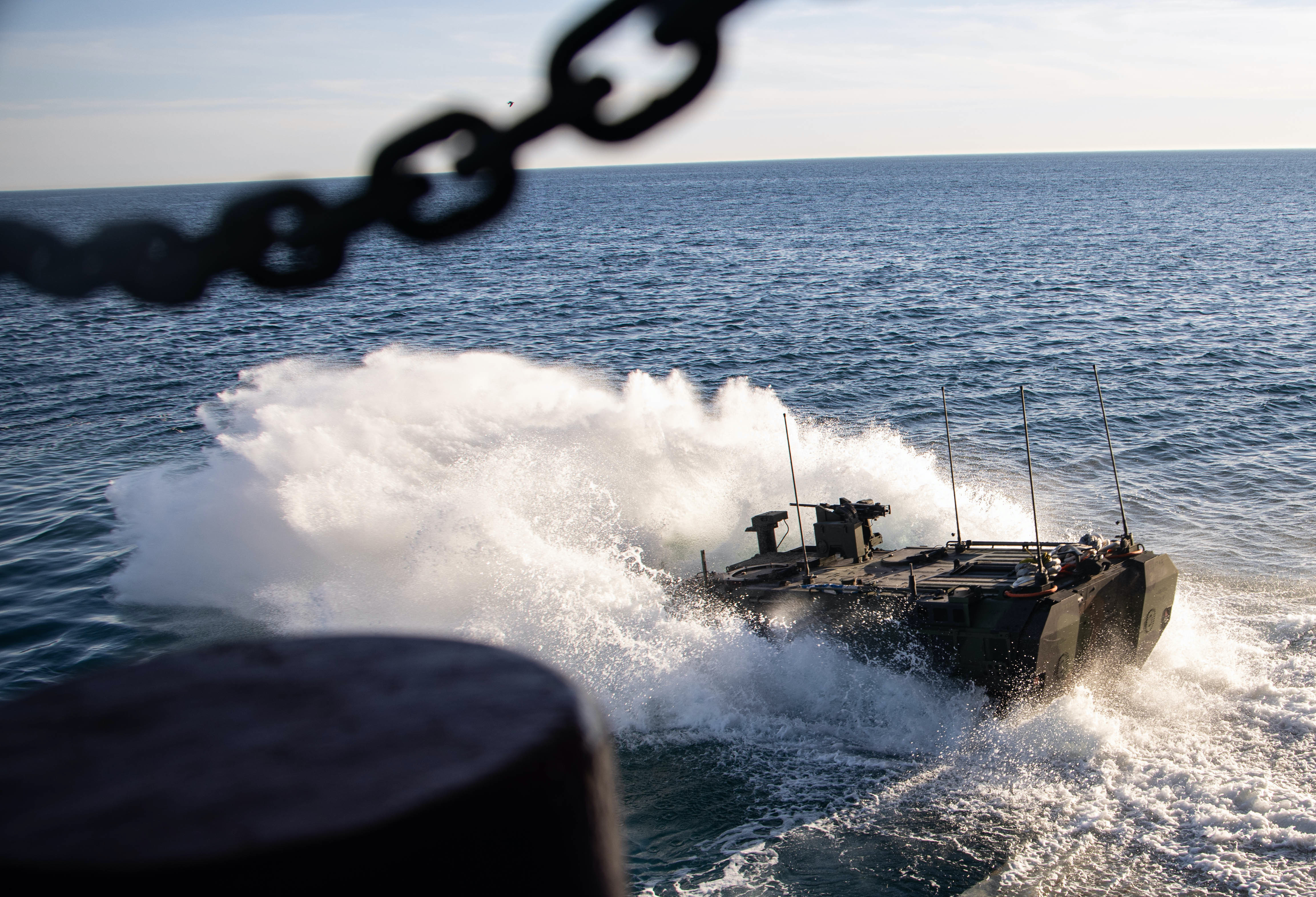
Two of his safety boats deployed ahead of the ACVs and remained at sea while the vehicles were in the water, something that wasn’t done in the 2020 mishap. “I launched safety boats from the ship to support the ACVs while they’re swimming, and we’ve increased the comms capabilities of those safety boats so they can maintain communications with the ACVs on their tactical radios,” Riebe said. At least one search-and-rescue swimmer joins the boat crews, who have radios to monitor and communicate on Boat Alpha and Boat Bravo, and can respond if there’s an issues with the vehicles.
Sailors and Marines reviewed safety measures and signals in the event of an emergency. The whole operation, said Riebe, is “controlled. I’m generally on the bridge of the ship for the evolution, where we’re paying close attention to all the details, ensuring we know the status of the crafts and that our safety boats are there.”
Staff Sgt. Nicholas Vickers, 1st Platoon’s third section leader, has spent his his 10-year career around amphibious tractors, operating AAVs and then the ACV with the Amphibious Vehicle Test Branch at Camp Pendleton and deploying to Japan and on ship with the 11th MEU.
“Our platoon has done an extensive amount of training in the water,” Vickers said, with seven iterations at Camp Pendleton’s boat basin before they did shore-to-shore operations along the beach and then the at-sea, integrated operations with Anchorage. “I think their well-deck crew and our Marines are on a really good baseline right now. Everyone understands what has to happen, and that’s enabled us to execute incredibly seamlessly,” he said.
“The more reps we get at it, the better they’re going to be,” he added.
Vickers said he and his section, with their five ACVs, worked “hand in hand” with the ship’s well-deck crew and bosun, boatswain’s mate, talking through procedures and doing debriefs after each mission. “ I think all the future operations with the Anchorage are going to be smoother,” he said, adding “the more time we spend with these guys, the more seamless it’s going to be.”
At-sea Familiarity
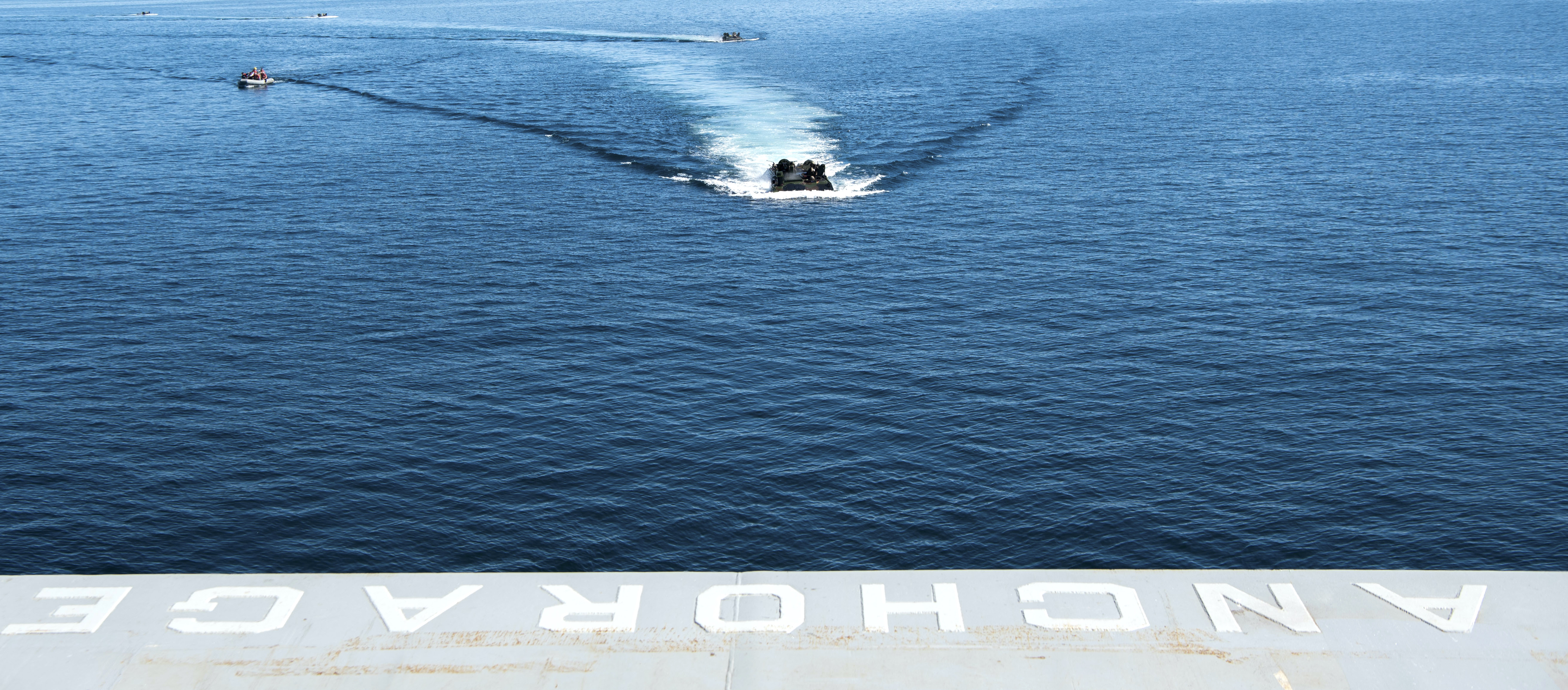
The at-sea training gave Anchorage and the ACV platoon more time, compared with the usual integrated, at-sea workups done during the pre-deployment training phase, to get familiar with each other’s capabilities, work through the training plan more closely, and even sort through differences in lingo and procedures like maneuvering the ACVs through the ship’s ramps and stowage decks. The ACVs are heavier and wider than the AAVs.
“It’s been great and just amazing watching the sailors and Marines just integrate and working side-by-side as one unit,” said Lt. Danny Muniz, the ship’s first lieutenant, adding that the at-sea training provided “additional reps and sets helping our well-deck team’s proficiency.”
At a pre-sail brief with ship’s captain days before the at-sea training, Brown went over procedures and no-go criteria, reviewed projected surf conditions and identified possible timeline delays due to weather or conditions. Then they did rehearsals that included scenarios of an ACV losing generator power and got Marines and sailors working through communication procedures, “like what emergency signals do we use?” he said. In an after-action briefing they sorted out how to report the downed vehicle’s location so the ship crew can properly mark which ACV it was in the water. Working through emergency scenarios that could happen, he added, “is preparing us to work together in the future.”

The day before the morning launch from Anchorage, Brown met with the captain, ship’s bosun, deck department and combat information center personnel to review the planned operation.
With both services revamping ACV standard operating procedures and manuals on well-deck operations and amphibious operations, the Marines and sailors have worked hard to memorize the changes and “ensure everyone’s on the same page when it comes to operating the ACVs and communications with vehicles and ships. We’re learning a lot together,” said Brown.
When at sea or ashore, he maintained communication with Anchorage. “The ship’s been really good about reaching out to me and being on comm when they say they are going to be,” he said. “So even if they’re 12 nautical miles out to sea, they’ll still be able to hear me. We’ll get in touch with each other early on, and we’ll pass all my personnel counts, what status are my vehicles in … and they’ll know what the modified surf index is at the beach that enables us to splash.”
Integrating with Infantry
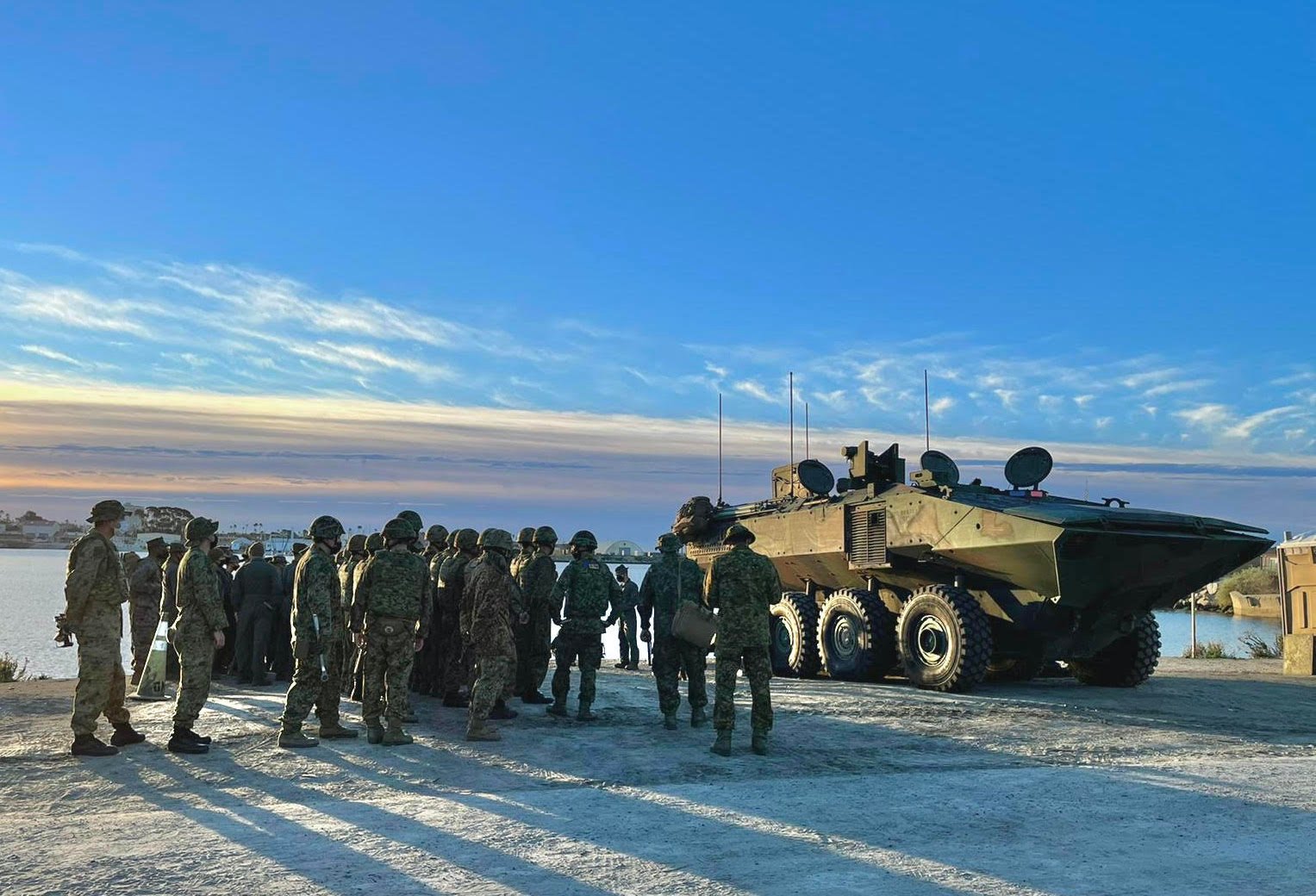
Another milestone comes in several weeks, when the ACV platoon is integrated and begins waterborne and ship-to-shore operations with embarked infantry Marines from Golf Company, 2/4. The ACV crews had completed their Marine Corps Combat Readiness Evaluation, but Brown said poor sea-state conditions prompted him to call off the amphibious portion of the evaluation, so that will occur at some point during the MEU workups.
Each ACV is crewed by three Marines: the vehicle commander, driver and gunner. The embarked infantry squads won’t just be sitting in the back. Instead of a rear crewman like in the AAV, one infantry Marine in each vehicle will serve as the “rear egress operator” – a new billet in an ACV. Guided by performance evaluation checklists Brown created, the Marines will be “looking at the water trigger lines. They’re the ones informing us what’s going on in the back, and helping folks out of the vehicle if we are in an emergency,” he said. “They have to learn how to do a myriad of things across the vehicle, and they have to learn how to lead folks through the evac egress training as well.”
Every troop commander will be familiar with the ACV’s remote weapons system, cameras and communications equipment that provide better situational awareness than the AAV, Brown said, so they can “look through the screens and see what our weapons are looking at, see where our vehicle is pointing at, and also know how to communicate via the radios and how to egress and lead egress, as well.”
“My biggest goal out of the upcoming training is to have the infantry gain comfortability seeing us do this,” Brown said. “We are trained. I’m fully confident in my crews and my sections and the platoon to execute what we’ve done. Where we’re going to make our money is the infantry knowing that we are capable of doing this, and seeing how the communication is and how we navigate ship-to-shore and shore-to-ship.”
Vickers said the infantry platoons will become more capable from the greater situational awareness while embarked on ACVs that “allows real-time updates” while still in the water during a mission. “The more that we work together, the better we’re going to get,” he said. “They could see what the gun sees, what the driver sees, what the vehicle commander sees,” and be able to listen to the radios in the back and what other vehicles are doing.





